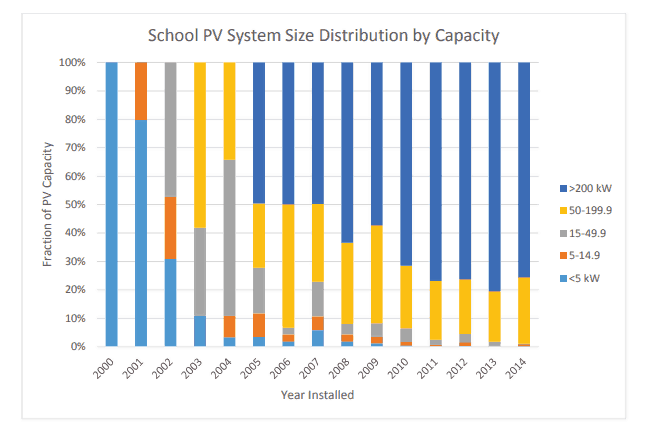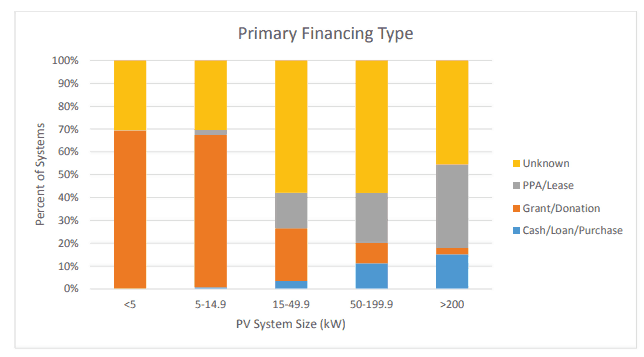Energy expenses in most schools and universities around the US represent the second most important expense after salaries for teachers.
Even though it could be a good area to save money, power utility costs cannot be easily trimmed in the school’s budget without negatively affecting the educational experience of the students.
Therefore, an alternative solution should be considered to offer the same benefits as power from the grid, but at a lower price. One of the solutions to this problem in the educational sector has been the use of solar power.
A recent study from the Environmental Research Letters titled Solar PV as a mitigation strategy for the US education sector approaches this statement very carefully.
Evaluating nearly 132 thousand educational institutions around the US, researchers estimated electricity generation, emissions reductions, and private and social net-benefits of installing solar PV on each K-12 public and private institution.
They found that K-12 schools in Texas could generate up to 10 TWh, up to 7.5 TWh in California, and nearly 4 TWh in Florida with available roof spaces. According to the study, nearly an additional 100 TWh can be generated with a total installed capacity of 64 GW if solar PV systems are installed in institutional education centers across the US.
This energy capacity would allow them to meet nearly 75% of their current electricity demands from the power grid.
This large potential for solar power makes institutional education centers consider if going solar would be a good choice.
To provide insights on this question, we can highlight some of the top benefits that an education center could obtain by going solar.
Check out our awesome solar powered tables!
Improve your sustainability with our innovative and fun solutions.
See the DashView WorkstationsSavings in Electricity
The first benefit that solar brings to the university or school community is related to the savings in electricity that can be obtained. On average, K-12 high schools consume nearly 10 kWh per square foot (ft2) per year.
A high school that encompasses between 900-1,000 students can have as many as 90-100 thousand square feet. This translates into a 900 – 1000 MWh consumption of electricity annually.
This energy consumption, according to US electricity rates, can vary between $60,000 (6 cents/kWh-Maine case) and $200,000 (20 cents/kWh-Alaska case) depending on the location of the school.
Combined with energy efficiency strategies, solar power offers an alternative to these schools that can allow them to cover over 75% of their energy needs using a sustainable and eco-friendly source of energy.
This will allow them to start saving money in the short and long-term over a 25 to 30-year period.
In the long span, according to a report from SEIA, schools could save up to $1,000,000 over 30 years.
The change is so promising that as of 2014, nearly 3,752 K-12 schools had already gone solar from which nearly half had installed PV systems above 50 kW and some had even installed large 1 MW size PV arrays.
The trend points out to installing large PV systems at a commercial level to cover as much energy needs as possible as can be seen in the figure below.

Schools located in states like Texas, California, and Florida would receive further benefits based on their energy consumptions and the costs of solar, according to the study.
Education in Sustainable Energy
The development of the renewable industry has also led to a new set of careers and promising fields of study. Particularly in universities and centers of research and development, by installing a PV system, students could have access to a real-world simulation practice for courses focused on solar PV power.
The ability to measure, see, touch, install and connect PV systems components provides additional elements that can influence the decision of a student to choose a university if he or she has interest in renewable energies.
Financial Options
To finance PV systems, schools and education centers have many choices available that go from fundraising, private donors or even state grants. Particularly for small PV systems, there is typically a trend in financing through donations or state grants.
Then, as the system rises, appear the other two choices that generally apply for solar at commercial.
In other words, PV systems above 15 kW are usually donated or paid under PPA or Cash options.
The Cash option involves a direct purchase or loan configuration. Under the direct purchase, the school instantly acquires ownership of the PV system.
Meanwhile, on the loan option, a down payment is made and the ownership belongs to the installer company until the school fully pays the price of solar.
The Power Purchase Agreement (PPA) involves a contract in which the installer owns the PV system and carries with it all the required maintenance costs of the array.
The school simply pays for the used electricity from the PV system at an electricity rate that is fixed over a 15 to 20-year period, and that is lower than the utility rate.
Particularly for school applications, as the PV system is bigger, it is more common to find financing through the PPA option due to higher capital costs.

How Solar Has Been Financed at K-12 Schools until 2014. Source: SEIA
Backup Power
Elementary schools, high-schools, universities, as well as large public places, serve many times as evacuation centers or shelters when natural disasters occur across the US.
Under natural disasters, the power grid can get disconnected due to damage in a power line or due to a failure in the stability of the grid. With solar powered and battery storage technologies, the school or university will be able to power critical loads for lighting and electrical power.
This is the best way to ensure that people under these circumstances will have access to electricity that could last for hours or days.
Multiple Installation Options
Finally, to install a solar power system in a school or university, there are many options available: roof-mount, ground-mount, solar carports, or building integrated photovoltaic (BIPV).
Particularly for schools and universities, the roof-mount option is a great way to take advantage of that available space.
Besides, roofs on this type of facility are generally flat, which is great for solar because it makes the installation easier, less risky for your roof, and unlike pitched roofs, allow setting the tilt and azimuth angles to optimum values.
Based on all these benefits and the latest trends in the solar power industry, installing a PV system is a wise choice for any educational institution in the US.
Read some case studies involving schools that use Sunbolt solar products.
View the Sunbolt solar powered tables.
References
https://www9.nationalgridus.com/non_html/shared_energyeff_college.pdf
https://iopscience.iop.org/article/10.1088/1748-9326/aafbcf/pdf
https://webspm.com/Articles/2015/07/01/School-Costs.aspx?m=1
https://www.xcelenergy.com/staticfiles/xe/Marketing/Managing-Energy-Costs-Schools.pdf
Check out our awesome solar powered tables!
Improve your sustainability with our innovative and fun solutions.
See the DashView Workstations
